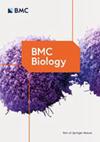全基因组分析揭示亚洲玉米螟(Ostrinia furnacalis)休眠期的转录和翻译变化
IF 4.4
1区 生物学
Q1 BIOLOGY
引用次数: 0
摘要
休眠是昆虫生命周期中的一个关键阶段,它能使昆虫在恶劣的环境条件下生存下来。揭示停歇过程的基因表达谱有助于发现停歇的分子机制,这对于理解生理适应至关重要。在本研究中,我们利用 RNA-seq 和 Ribo-seq 数据研究了亚洲玉米螟(Ostrinia furnacalis, ACB)休眠过程中的差异表达基因(DEGs)和翻译效率。我们的结果揭示了在休眠期被分为 "前向"、"排他性"、"强化 "或 "缓冲 "的基因,揭示了它们的转录和翻译调控模式。此外,我们还探索了非编码长RNA(lncRNAs)在休眠期的表达格局,并鉴定了差异表达的lncRNAs,提示它们在休眠调控中的作用。对昆虫不同类型休眠的比较分析发现了共享和独特的 KEGG 通路。共享通路强调能量平衡,而ACB幼虫的独有通路则表明昆虫在营养利用和应激反应方面的特异性适应。有趣的是,我们的研究还揭示了休眠期 HSP70 基因家族和蛋白酶体通路的动态变化。通过 HSP 激活剂或抑制剂以及蛋白酶体抑制剂操纵 HSP 蛋白水平和蛋白酶体途径会影响休眠,这表明它们在休眠过程中起着重要作用。总之,这些发现增进了我们对昆虫如何通过复杂的分子机制在具有挑战性的条件下生存的了解。本文章由计算机程序翻译,如有差异,请以英文原文为准。
Genome-wide analysis reveals transcriptional and translational changes during diapause of the Asian corn borer (Ostrinia furnacalis)
Diapause, a pivotal phase in the insect life cycle, enables survival during harsh environmental conditions. Unraveling the gene expression profiles of the diapause process helps uncover the molecular mechanisms that underlying diapause, which is crucial for understanding physiological adaptations. In this study, we utilize RNA-seq and Ribo-seq data to examine differentially expressed genes (DEGs) and translational efficiency during diapause of Asian corn borer (Ostrinia furnacalis, ACB). Our results unveil genes classified as “forwarded”, “exclusive”, “intensified”, or “buffered” during diapause, shedding light on their transcription and translation regulation patterns. Furthermore, we explore the landscape of lncRNAs (long non-coding RNAs) during diapause and identify differentially expressed lncRNAs, suggesting their roles in diapause regulation. Comparative analysis of different types of diapause in insects uncovers shared and unique KEGG pathways. While shared pathways highlight energy balance, exclusive pathways in the ACB larvae indicate insect-specific adaptations related to nutrient utilization and stress response. Interestingly, our study also reveals dynamic changes in the HSP70 gene family and proteasome pathway during diapause. Manipulating HSP protein levels and proteasome pathway by HSP activator or inhibitor and proteasome inhibitor affects diapause, indicating their vital role in the process. In summary, these findings enhance our knowledge of how insects navigate challenging conditions through intricate molecular mechanisms.
求助全文
通过发布文献求助,成功后即可免费获取论文全文。
去求助
来源期刊

BMC Biology
生物-生物学
CiteScore
7.80
自引率
1.90%
发文量
260
审稿时长
3 months
期刊介绍:
BMC Biology is a broad scope journal covering all areas of biology. Our content includes research articles, new methods and tools. BMC Biology also publishes reviews, Q&A, and commentaries.
 求助内容:
求助内容: 应助结果提醒方式:
应助结果提醒方式:


